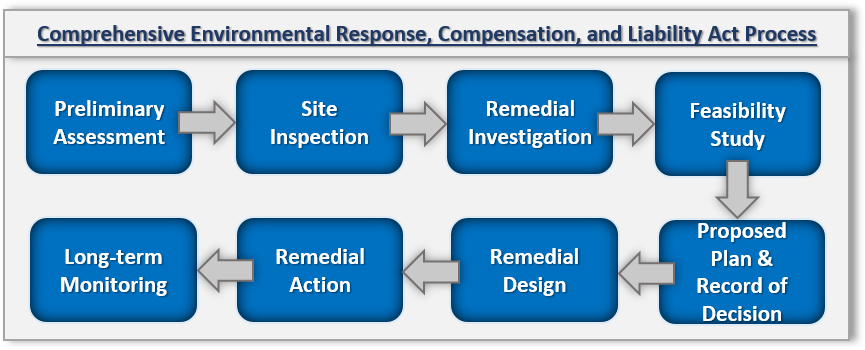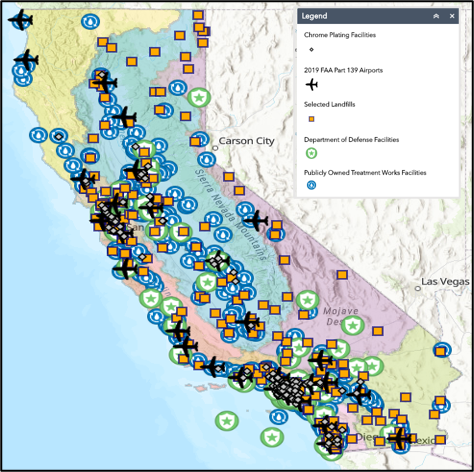
Military
Military PFAS Information and Resources
Military installations started using Aqueous Film Forming Foam (AFFF) in the 1970’s as a firefighting agent to extinguish chemical fires or spills but was also used during crash crew training exercises, hanger system operations and testing, and for other emergency response actions. The Department of Defense (DoD) also uses materials that can contain per- and polyfluoroalkyl substances (PFAS) in the vapor suppression systems at plating shops.
Through 2001, perfluorooctane sulfonic acid (PFOS) and, in some formulations, perfluorooctanoic acid (PFOA) were used in the manufacture of AFFF. Manufacturers of AFFF in the United States use other PFAS other than PFOS; however, existing stocks of PFOS-based AFFF remain in use. By 2015, the primary U.S. manufacturers voluntarily phased out production of PFOS and PFOA.
The DoD updated the Military Specification (MILSPEC) for AFFF, so that new supplies available for emergency firefighting responses, do not contain detectable levels of PFOS or PFOA. AFFF is still used by the DoD only to respond to emergency events and treats each use as a spill to limit environmental effects. AFFF is no longer used for maintenance, testing, or training on DoD installations world-wide. The DoD is assessing substitutes for PFAS in AFFF. The latest environmental research, such as finding a PFAS-free AFFF formulation or treating PFAS-contaminated soil, is being performed by the DoD under the Strategic Environmental Research and Development Program (SERDP) and Environmental Security Technology Certification Program (ESTCP) programs. For more information: https://www.serdp-estcp.org/
Since 2014 or 2015, DoD has been addressing PFAS with preliminary assessments, site investigations, and corrective actions under the Comprehensive Environmental Response, Compensation, and Liability Act (CERCLA) which will be a multi-year process. In 2019, DoD established a PFAS task force to address PFAS at military installations and surrounding communities. The latest task force update is located at: Department of Defense Per- and Polyfluoroalkyl Substances (PFAS) Task Force Progress Report, March 2020.

On July 14, 2021, the DoD held a public outreach event which detailed the roles and responsibilities, funding process, and actions taken as part of the department’s clean up efforts related to PFAS contamination of local communities. The presentation also detailed the DoD’s future goals related to public health outcomes, such as mitigating the future use of AFFF, monitoring the health of firefighters exposed to PFAS, and expanding PFAS related public outreach.
As of May 2020, California has 62 military facilities with a known or suspected per- and polyfluoroalkyl substances (PFAS) release. Since the Comprehensive Environmental Response, Compensation, and Liability Act (CERCLA) process is a multi-year process with streamlined steps to identify if there is a problem, what the risks are, and how-to cleanup, facilities will be addressed as funding permits. For more information regarding a PFAS investigations at a California military facility, refer to the Department of Defense PFAS Website: https://www.defense.gov/Explore/Spotlight/pfas/.
AIRFORCE
- Air Force Plant 42
- Beale Air Force Base
- Castle Air Force Base
- Channel Islands ANGS
- Edwards Air Force Base
- Fresno ANG Base
- George Air Force Base
- Los Angeles Air Force Base
- March Air Force Base
- March Air Reserve Base
- Mather Air Force Base
- McClellan Air Force Base
- Moffett Field ANG Station
- Norton Air Force Base
- Onizuka Air Force Station
- Ontario ANG Station
- Travis Air Force Base
- Vandenberg Air Force Base
ARMY
- AFRC Los Alamitos
- Army Aviation Support ARNG Stockton
- Camp Roberts
- Camp San Luis Obispo
- Fort Hunter Liggett
- Fort Irwin
- Fort Ord
- Fresno ARNG TASMG
- Military Ocean Terminal Concord
- Roseville Armory ARNG
- Sacramento AASF
- Sharpe Army Depot
- Sierra Army Depot
NAVY / MARINE CORPS
- Alameda Naval Complex
- Azusa NCCOSC Morris Dam
- Concord NWS
- Coronado Naval Amphibious Base
- Crows Landing NALF
- Hunter Point NSY
- Long Beach NS
- Long Beach NSY
- Mare Island Naval Complex
- Marine Corps Air Station El Toro
- Marine Corps Air Station Tustin
- Marine Corps Logistics Base Barstow
- MCAGCC Twenty Nine Palms
- MCAS Miramar
- MCB Camp Pendleton
- NAF El Centro
- Naval Air Station Lemoore
- Naval Air Weapons Station China Lake
- Naval Base Ventura County, Point Mugu
- Naval Base Ventura County, Port Hueneme
- Naval Base Ventura County, San Nicolas Island
- NAVBASE Coronado
- NAVBASE Point Loma (SUBBASE)/SPAWAR (SSC)
- NAVBASE San Diego
- NAVCOMTELSTA Stockton
- NAVWPNSTA Seal Beach
- NAVWPNSTA Seal Beach Fallbrook
- NOLF Imperial Beach
- San Diego AUXLNDFLD NAVBASE Coronado
- San Diego FASWTC PAC NAVBASE Point Loma
- San Diego Nise-West NAVBASE Point Loma
- Treasure Island Naval Complex
The State Water Board’s Division of Drinking Water (DDW) and Division of Water Quality (DWQ) are working closely with the Department of Defense (DoD) on identifying and sampling of appropriate municipal supply drinking water wells and drinking water systems that may be at risk to per- and polyfluoroalkyl substances (PFAS) contamination from historic military operations.
Past Efforts:
To ensure safe drinking water, the DoD is proactively sampling drinking water systems on facilities and sampling private drinking water wells off-base if there was a suspected or known release that potentially migrated from a facility. It is a priority for the DoD to address PFAS to protect those living and working on a facility as well as the surrounding communities that may have been impacted. This is a national and international effort to identify releases, investigate and respond to drinking water contamination, and prevent future contamination of PFAS at military facilities.
Between 2013 and 2015, 63 DoD drinking water systems nationwide were required to be sampled for a suite of chemicals, perfluorooctanoic acid (PFOA) and perfluorooctane sulfonic acid (PFOS) included, as part of the U.S. Environmental Protection Agency’s (EPA) Unregulated Contaminant Monitoring Rule program. Only one system (Wright Patterson Air Force Base, Ohio) detected levels above the EPA's (EPA) Provisional Health Advisory.
- The Third Unregulated Contaminant Monitoring Rule (UCRM3) Report: https://www.epa.gov/dwucmr/data-summary-third-unregulated-contaminant-monitoring-rule
In 2016, the military tested for PFOA/PFOS in drinking water systems (samples were collected after treatment or blending) where DoD supplies the drinking water. Samples that tested above the EPA’s PFOA or PFOS lifetime health advisory (LHA) of 70 parts per trillion (ppt), those wells were taken offline and systems were re-tested until results were less than EPA’s PFOA/PFOS LHA. If unable to isolate the source of the PFAS coming into the system and it tested above the LHA, then the DoD provided alternative drinking water. Facilities that DoD is not the drinking water supplier encouraged those suppliers to test the drinking water system and follow EPA advisory recommendations. As of 2017, DoD has conducted off-base testing at 2,445 public and private drinking water systems nationwide as part of the Comprehensive Environmental Response, Compensation, and Liability Act (CERCLA) process.
- Maureen Sullivan Presentation to EPA PFAS Summit, May 2018: https://www.epa.gov/sites/production/files/2018-05/documents/dod_presentation_epa_summit_pfos_pfoa_may2018_final.pptxx_.pdf
Future Efforts:
DDW and DWQ are identifying non-military owned municipal supply wells in proximity to military bases under PFAS investigation for future sampling under Health & Safety Code 116378 likely in late 2020 or early 2021.
For military owned municipal drinking water systems that are on facilities under PFAS investigation, the DoD will be implementing their March 2, 2020, DoD drinking water memo.
As future PFAS information for drinking water wells and systems becomes available, information will be provided on the State Water Board’s PFAS Drinking Water Website: https://www.waterboards.ca.gov/pfas/drinking_water.html.
Department of Defense PFAS Website
Air Force
For more information about Air Force response to PFAS:
https://www.afcec.af.mil/WhatWeDo/Environment/Perfluorinated-Compounds/
Administrative Record for the Air Force:
https://ar.afcec-cloud.af.mil/
Navy and U.S. Marine Corps
For more information about Navy and Marine Corps response to PFAS:
https://cnrsw.cnic.navy.mil/Operations-and-Management/Environmental-Support/Drinking-Water-Quality-Information/PFAS/
Administrative Record for the Navy/Marine Corps:
https://www.navfac.navy.mil/products_and_services/ev/products_and_services/env_restoration/installation_map/states/california.html
Army
For more information about Army response to PFAS:
https://www.denix.osd.mil/army-pfas/home/
Administrative Record Locations for Active Army Installations:
- Sierra Army Depot
74 Currant St, Herlong, CA 96113 - Military Ocean Terminal - Concord
410 Norman Ave, Concord, CA 94520 - Parks Reserve Forces Training Area
300 Adams Ave, Dublin, CA 94568-5201 - Fort Hunter Liggett
Building 243, Jolon, CA 93928
- National Training Center / Fort Irwin
Building 4999, NTC-Ft Irwin, CA 92310 - Presidio of Monterey
Bldg. 4463 Gigling Road, Seaside, CA 93955 - Sharpe Army Depot
700 Roth Road Bldg. 404, Lathrop, CA 95330
Subscribe to the PFAS Email List
Subscribe to our Per- and Polyfluoroalkyl Substances (PFAS) email list to receive notifications and the latest updates. After subscribing, you will need to check your email host for a confirmation email to complete the subscription.
Subscribe to our other email lists. See the "Water Quality" section.
Quick Links
Questions? Comments?
If you have questions about our program, please email us at:
For additional information about PFAS
- Division of Drinking Water District Engineers
- GeoTracker Help Desk
- ITRC PFAS Fact Sheets (English and Spanish)
- Regional Water Board Contacts
- US EPA PFAS Website
- San Diego Regional Water Quality Control Board — PFAS website
- San Francisco Regional Water Quality Control Board — PFAS website
- Santa Ana Regional Water Quality Control Board — PFAS website
- Los Angeles Regional Water Quality Control Board – PFAS website
Military PFAS Additional Resources
- Department of Defense PFAS Website
- Department of Defense PFAS Drinking Water Website
- Air Force PFAS Website
- Air Force Administrative Record
- Department of the Navy PFAS Website
- NAVFAC North West PFAS Website
- NAVFAC Pacific and BRAC PMO Environmental Restoration Installations Administrative Record
- Army PFAS Website
- Department of Defense’s Environmental Research Programs Web



